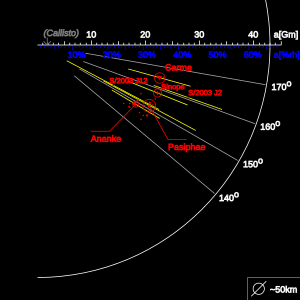Ananke (moon)
 | |
| Discovery | |
|---|---|
| Discovered by | S. B. Nicholson |
| Discovery date | September 28, 1951 |
| Orbital characteristics | |
| Periapsis | 12,567,000 km |
| Apoapsis | 29,063,500 km |
Mean orbit radius | 21,280,000 km[1] |
| Eccentricity | 0.24[1] |
| 610.45 d (1.680 a)[1] | |
Average orbital speed | 2.367 km/s |
| Inclination | 148.89° (to the ecliptic) 149.9° (to Jupiter's equator)[1] |
| Satellite of | Jupiter |
| Physical characteristics | |
| 14 km[2] | |
| ~2500 km2 | |
| Volume | ~11,500 km3 |
| Mass | 3.0×1016 kg |
Mean density | 2.6 g/cm3 (assumed) |
| 0.010 m/s2 (0.001 g) | |
| ~0.017 km/s | |
| Albedo | 0.04 (assumed)[2] |
| Temperature | ~124 K |
Ananke (/əˈnæŋkiː/ ə-NANG-kee; [Ανάγκη] Error: {{Lang-xx}}: text has italic markup (help)) is a retrograde irregular moon of Jupiter. It was discovered by Seth Barnes Nicholson at Mount Wilson Observatory in 1951[3] and is named after the mythological Ananke, the personification of Necessity, and the mother of the Moirai by Zeus. The adjectival form of the name is Anankean.
Ananke did not receive its present name[4] until 1975;[5] before then, it was simply known as Jupiter XII. It was sometimes called "Adrastea"[6] between 1955 and 1975 (Adrastea is now the name of another satellite of Jupiter).
Ananke gives its name to the Ananke group, retrograde irregular moons which orbit Jupiter between 19.3 and 22.7 Gm, at inclinations of roughly 150°.[2]
Orbit
Ananke orbits Jupiter on a high eccentricity and high inclination retrograde orbit. Eight irregular satellites orbiting Jupiter have been discovered since 2000 following similar orbits.[2] The orbital elements are as of January 2000.[1] They are continuously changing due to Solar and planetary perturbations. The diagram illustrates Ananke's orbit in relation to other retrograde irregular satellites of Jupiter. The eccentricity of selected orbits is represented by the yellow segments (extending from the pericentre to the apocentre). The outermost regular satellite Callisto is located for reference.
Given these orbital elements and the physical characteristics known so far, Ananke is thought to be the largest remnant[7] of an original break-up forming the Ananke group.[8][9]
Physical characteristics
In the visible spectrum, Ananke appears neutral to light-red (colour indices B-V=0.90 V-R=0.38).[9]
The infrared spectrum is similar to P-type asteroids but with a possible indication of water.[10]

See also
References
- ^ a b c d e Jacobson, R. A. (2000). "The Orbits of Outer Jovian Satellites". Astronomical Journal. 120 (5): 2679–2686. Bibcode:2000AJ....120.2679J. doi:10.1086/316817.
- ^ a b c d Sheppard, S. S., Jewitt, D. C., Porco, C.; Jupiter's Outer Satellites and Trojans, in Jupiter: The Planet, Satellites and Magnetosphere, edited by Fran Bagenal, Timothy E. Dowling, William B. McKinnon, Cambridge Planetary Science, Vol. 1, Cambridge, UK: Cambridge University Press, ISBN 0-521-81808-7, 2004, pp. 263-280
- ^ Nicholson, S. B. (1951). "An unidentified object near Jupiter, probably a new satellite". Publications of the Astronomical Society of the Pacific. 63 (375): 297–299. Bibcode:1951PASP...63..297N. doi:10.1086/126402.
- ^ Nicholson, S.B. (April 1939). "S. B. Nicholson declines to name the satellites of Jupiter he has discovered". Publications of the Astronomical Society of the Pacific. 51 (300): 85–94. Bibcode:1939PASP...51...85N. doi:10.1086/125010.
- ^ Marsden, B. G. (7 October 1974). "Satellites of Jupiter". IAUC Circular. 2846.
- ^ Payne-Gaposchkin, Cecilia; Katherine Haramundanis (1970). Introduction to Astronomy. Englewood Cliffs, N.J.: Prentice-Hall. ISBN 0-13-478107-4.
- ^ Sheppard, S.S.; Jewitt, D.C. (2003). "An abundant population of small irregular satellites around Jupiter" (PDF). Nature. 423 (6937): 261–263. Bibcode:2003Natur.423..261S. doi:10.1038/nature01584. PMID 12748634. Archived from the original (PDF) on August 13, 2006.
{{cite journal}}: Unknown parameter|deadurl=ignored (|url-status=suggested) (help) - ^ Nesvorný, D.; Beaugé, C.; Dones, L. (2004). "Collisional Origin of Families of Irregular Satellites". The Astronomical Journal. 127 (3): 1768–1783. Bibcode:2004AJ....127.1768N. doi:10.1086/382099.
- ^ a b Grav, Tommy; Holman, M. J.; Gladman, B. J.; Aksnes, K. (2003). "Photometric survey of the irregular satellites". Icarus. 166 (1): 33–45. arXiv:astro-ph/0301016. Bibcode:2003Icar..166...33G. doi:10.1016/j.icarus.2003.07.005.
- ^ Grav, Tommy; Holman, Matthew J. (2004). "Near-Infrared Photometry of the Irregular Satellites of Jupiter and Saturn". The Astrophysical Journal. 605 (2): L141–L144. arXiv:astro-ph/0312571. Bibcode:2004ApJ...605L.141G. doi:10.1086/420881.
Sources
- Ephemeris IAU-MPC NSES
